Exploring Loops
Understanding while Loops
You can make a block of code execute over and over again using a while statement. The code in a while clause will be executed as long as the while statement’s condition is True. In code, a while statement always consists of the following:
- The
whilekeyword - A condition (that is, an expression that evaluates to True or False)
- A colon
- Starting on the next line, an indented block of code (called the
whileclause)
You can see that a while statement looks similar to an if statement. The difference is in how they behave. At the end of an if clause, the program execution continues after the if statement. But at the end of a while clause, the program execution jumps back to the start of the while statement. The while clause is often called the while loop or just the loop.
Let’s look at an if statement and a while loop that use the same condition and take the same actions based on that condition. Here is the code with an if statement:
spam = 0
if spam < 5:
print('Hello, world.')
spam = spam + 1
Here is the code with a while statement:
spam = 0
while spam < 5:
print('Hello, world.')
spam = spam + 1
These statements are similar—both if and while check the value of spam, and if it’s less than 5, they print a message. But when you run these two code snippets, something very different happens for each one. For the if statement, the output is simply "Hello, world.". But for the while statement, it’s "Hello, world." repeated five times! Take a look at the flowcharts for these two pieces of code to see why this happens.
If Flowchart
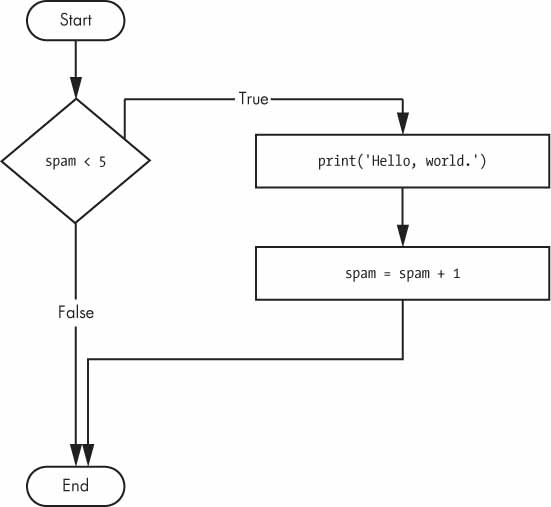
While Flowchart
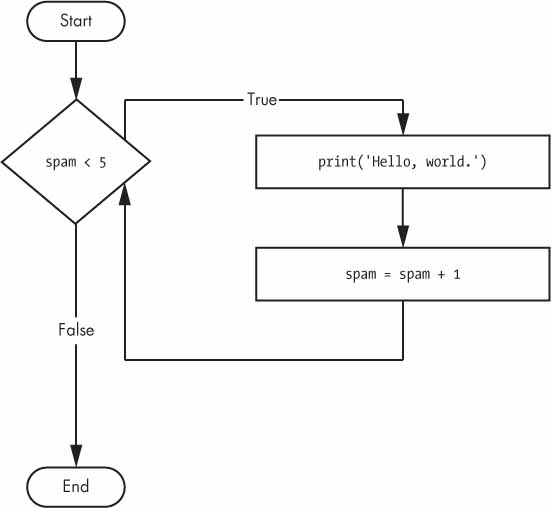
The code with the if statement checks the condition, and it prints Hello, world. only once if that condition is true. The code with the while loop, on the other hand, will print it five times. The loop stops after five prints because the integer in spam increases by one at the end of each loop iteration, which means that the loop will execute five times before spam < 5 is False.
In the while loop, the condition is always checked at the start of each iteration (that is, each time the loop is executed). If the condition is True, then the clause is executed, and afterward, the condition is checked again. The first time the condition is found to be False, the while clause is skipped.
An Annoying while Loop
Here’s a small example program that will keep asking you to type, literally, your name.
name = ''
while name != 'your name':
print('Please type your name.')
name = input()
print('Thank you!')
Execute this program in Replit. Once you understand how it works, use the debugger to walk through the code step by step.
First, the program sets the name variable to an empty string. This is so that the name != 'your name' condition will evaluate to True and the program execution will enter the while loop’s clause.
The code inside this clause asks the user to type their name, which is assigned to the name variable. Since this is the last line of the block, the execution moves back to the start of the while loop and reevaluates the condition. If the value in name is not equal to the string 'your name', then the condition is True, and the execution enters the while clause again.
But once the user types your name, the condition of the while loop will be 'your name' != 'your name', which evaluates to False. The condition is now False, and instead of the program execution reentering the while loop’s clause, Python skips past it and continues running the rest of the program.
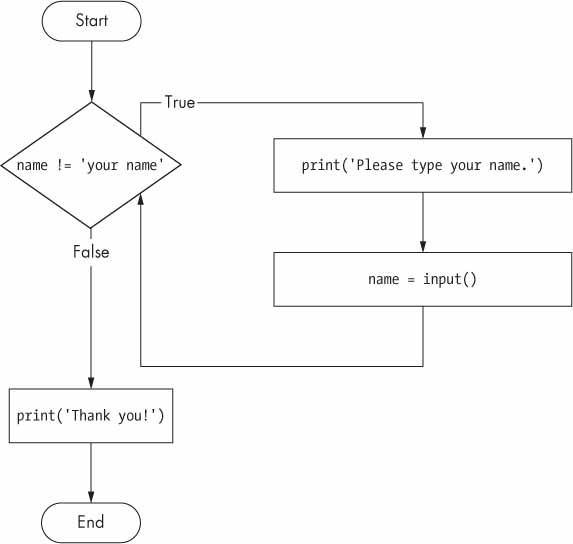
Please type your name.
Al
Please type your name.
Albert
Please type your name.
%#@#%*(^&!!!
Please type your name.
your name
Thank you!
If you never enter your name, then the while loop’s condition will never be False, and the program will just keep asking forever. Here, the input() call lets the user enter the right string to make the program move on. In other programs, the condition might never actually change, and that can be a problem. Let’s look at how you can break out of a while loop.
Using break to Exit a Loop
There is a shortcut to getting the program execution to break out of a while loop’s clause early. If the execution reaches a break statement, it immediately exits the while loop’s clause. In code, a break statement simply contains the break keyword.
Pretty simple, right? Here’s a program that does the same thing as the previous program, but it uses a break statement to escape the loop.
while True:
print('Please type your name.')
name = input()
if name == 'your name':
break
print('Thank you!')
The first line creates an infinite loop; it is a while loop whose condition is always True. (The expression True, after all, always evaluates down to the value True.) After the program execution enters this loop, it will exit the loop only when a break statement is executed. (An infinite loop that never exits is a common programming bug.)
Just like before, this program asks the user to enter your name. Now, however, while the execution is still inside the while loop, an if statement checks whether name is equal to 'your name'. If this condition is True, the break statement is run, and the execution moves out of the loop to print('Thank you!'). Otherwise, the if statement’s clause that contains the break statement is skipped, which puts the execution at the end of the while loop. At this point, the program execution jumps back to the start of the while statement to recheck the condition. Since this condition is merely the True Boolean value, the execution enters the loop to ask the user to type your name again.
Run this program in Replit to get a feel for how it's working and then use the debugger to walk through the code step by step.
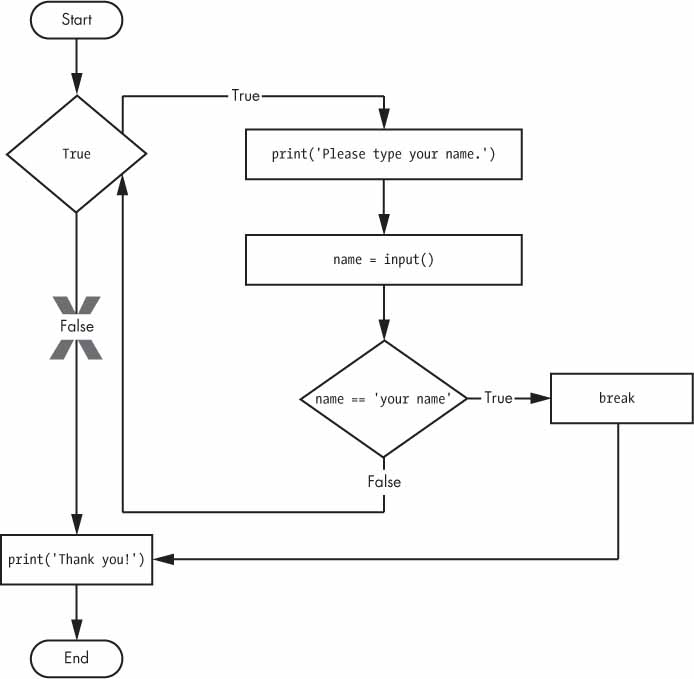
Using continue in a Loop
Like break statements, continue statements are used inside loops. When the program execution reaches a continue statement, the program execution immediately jumps back to the start of the loop and reevaluates the loop’s condition. (This is also what happens when the execution reaches the end of the loop.)
Let’s use continue to write a program that asks for a name and password.
Trapped in an inifite loop? Press Ctrl + c to stop the program.
while True:
print('Who are you?')
name = input()
if name != 'Joe':
continue
print('Hello, Joe. What is the password? (It is a fish.)')
password = input()
if password == 'swordfish':
break
print('Access granted.')
If the user enters any name besides Joe, the continue statement causes the program execution to jump back to the start of the loop. When the program reevaluates the condition, the execution will always enter the loop, since the condition is simply the value True. Once the user makes it past that if statement, they are asked for a password. If the password entered is swordfish, then the break statement is run, and the execution jumps out of the while loop to print Access granted. Otherwise, the execution continues to the end of the while loop, where it then jumps back to the start of the loop.
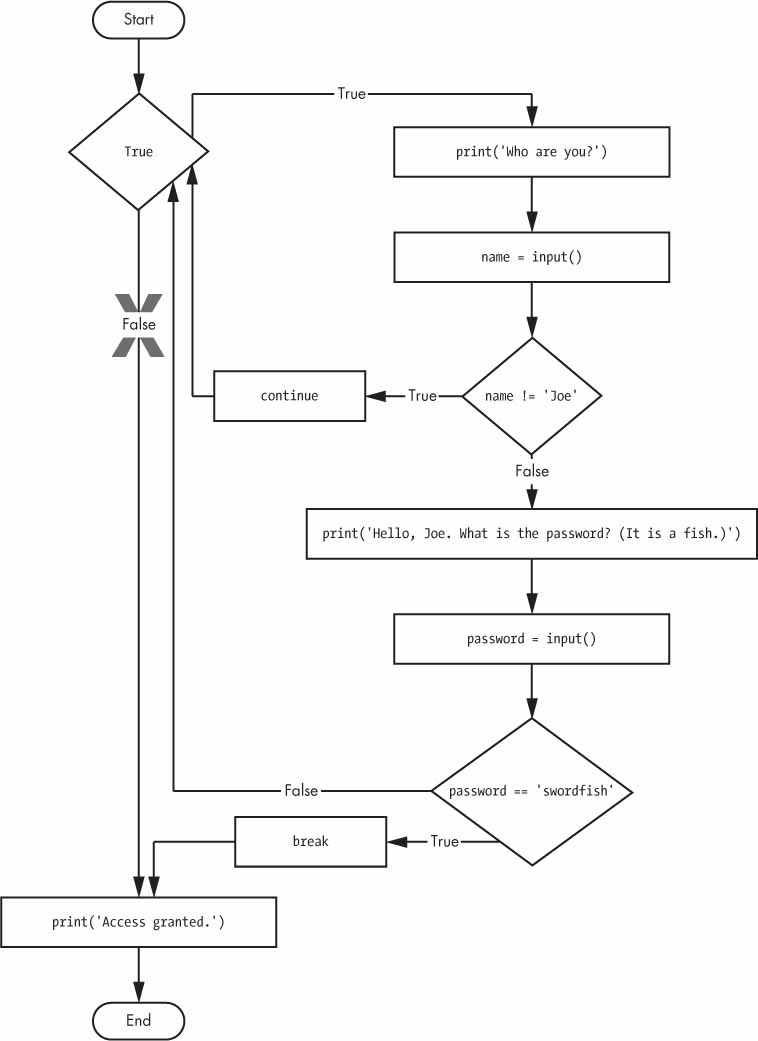
'Truthy' and 'Falsey' Values
Conditions will consider some values in other data types equivalent to True and False. When used in conditions, 0, 0.0, and '' (the empty string) are considered False, while all other values are considered True. For example, look at the following program:
name = ''
while not name:
print('Enter your name:')
name = input()
print('How many guests will you have?')
num_of_guests = int(input())
if num_of_guests:
print('Be sure to have enough room for all your guests.')
print('Done')
If the user enters a blank string for name, then the while statement’s condition will be True, and the program continues to ask for a name. If the value for num_of_guests is not 0, then the condition is considered to be True, and the program will print a reminder for the user.
You could have entered not name != '' instead of not name, and num_of_guests != 0 instead of num_of_guests, but using the truthy and falsey values can (sometimes) make your code easier to read.
For Loops and the range() Function
The while loop keeps looping while its condition is True (which is the reason for its name), but what if you want to execute a block of code only a certain number of times? You can do this with a for loop statement and the range() function.
In code, a for statement looks something like for i in range(5): and includes the following:
- The
forkeyword - A variable name
- The
inkeyword - A call to the
range()method with up to three integers passed to it - A colon
- Starting on the next line, an indented block of code (called the for clause)
print('My name is')
for i in range(5):
print('Jimmy Five Times (' + str(i) + ')')
The code in the for loop’s clause is run five times. The first time it is run, the variable i is set to 0. The print() call in the clause will print Jimmy Five Times (0). After Python finishes an iteration through all the code inside the for loop’s clause, the execution goes back to the top of the loop, and the for statement increments i by one. This is why range(5) results in five iterations through the clause, with i being set to 0, then 1, then 2, then 3, and then 4. The variable i will go up to, but will not include, the integer passed to range().
When you run this program, it should print Jimmy Five Times followed by the value of i five times before leaving the for loop.
My name is
Jimmy Five Times (0)
Jimmy Five Times (1)
Jimmy Five Times (2)
Jimmy Five Times (3)
Jimmy Five Times (4)
NOTE: You can use
breakandcontinuestatements insideforloops as well. Thecontinuestatement willcontinueto the next value of theforloop’s counter, as if the program execution had reached the end of the loop and returned to the start. In fact, you can usecontinueandbreakstatements only insidewhileandforloops. If you try to use these statements elsewhere, Python will give you an error.
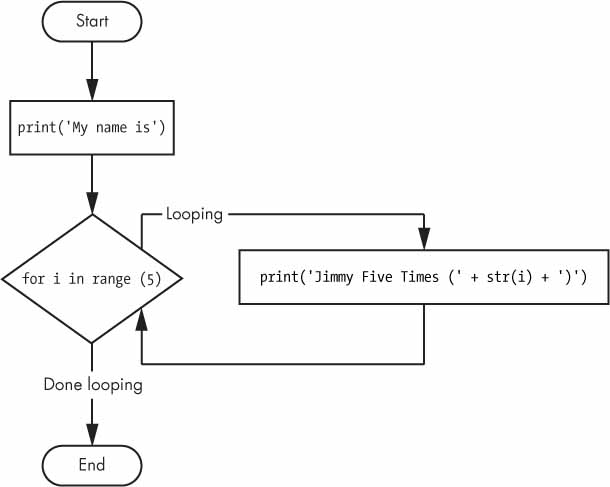
As another for loop example, consider this story about the mathematician Carl Friedrich Gauss. When Gauss was a boy, a teacher wanted to give the class some busywork. The teacher told them to add up all the numbers from 0 to 100. Young Gauss came up with a clever trick to figure out the answer in a few seconds, but you can write a Python program with a for loop to do this calculation for you.
total = 0
for num in range(101):
total = total + num
print(total)
The result should be 5,050. When the program first starts, the total variable is set to 0. The for loop then executes total = total + num 100 times. By the time the loop has finished all of its 100 iterations, every integer from 0 to 100 will have been added to total. At this point, total is printed to the screen. Even on the slowest computers, this program takes less than a second to complete.
An Equivalent While Loop
You can actually use a while loop to do the same thing as a for loop; for loops are just more concise. Let’s rewrite our program to use a while loop equivalent of a for loop.
print('My name is')
i = 0
while i < 5:
print('Jimmy Five Times (' + str(i) + ')')
i = i + 1
If you run this program, the output should look the same as the original program, which uses a for loop.
The Starting, Stopping, and Stepping Arguments to range()
Some functions can be called with multiple arguments separated by a comma, and range() is one of them. This lets you change the integer passed to range() to follow any sequence of integers, including starting at a number other than zero.
for i in range(12, 16):
print(i)
The first argument will be where the for loop’s variable starts, and the second argument will be up to, but not including, the number to stop at.
12
13
14
15
The range() function can also be called with three arguments. The first two arguments will be the start and stop values, and the third will be the step argument. The step is the amount that the variable is increased by after each iteration.
for i in range(0, 10, 2):
print(i)
So calling range(0, 10, 2) will count from zero to eight by intervals of two.
0
2
4
6
8
The range() function is flexible in the sequence of numbers it produces for for loops. For example, you can even use a negative number for the step argument to make the for loop count down instead of up.
for i in range(5, -1, -1):
print(i)
This for loop would have the following output:
5
4
3
2
1
0
Running a for loop to print i with range(5, -1, -1) should print from five down to zero.